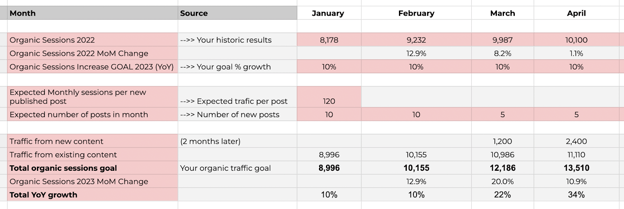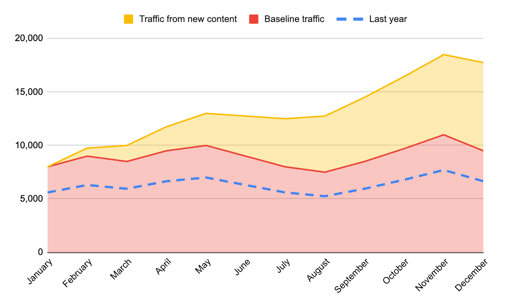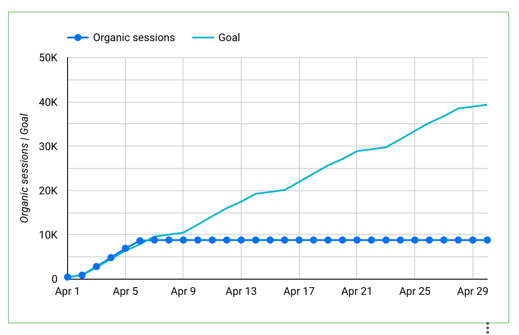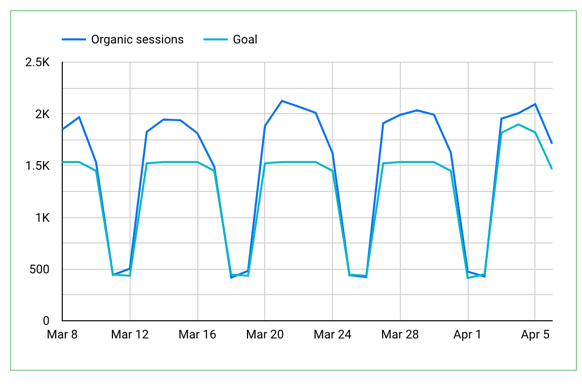-
 Written by Thomas Frenkiel
Written by Thomas FrenkielThomas has over 10 years of marketing experience. After working in media and SEO agencies for 8 years, he joined Funnel in 2022.
Tracking results is essential in digital marketing. Not only in advertising and performance marketing, but also in SEO. And while you can track SEO performance by comparing results to previous periods, sometimes “just growth” isn’t enough. Sometimes, you need to be more specific about the amount of growth you are trying to achieve. Enter: SEO goal setting.
I don’t want to spend too much time on what goal setting is, or why it is important. You’re reading this, so you probably understand its importance already. What we will focus on, instead, is the method. How to set goals for SEO that make sense and are grounded in reality.
This is not an easy feat. You want to make sure you are setting ambitious, yet achievable, goals. In this blogpost, I will explain three common ways to set SEO goals, discuss which one is my personal favorite, and share a Google Sheets template you can use right now to set SEO goals.
Before we dive in, this post is about setting two types of goals:
- Organic search traffic goals
- Conversion goals from that traffic
There are many SEO metrics you can use to track your performance (the number of queries your site ranks for, the percentage of web pages that are indexed by Google, etc.), but I won’t go into those right now.
Goal setting for SEO
method one: Year-on-year organic traffic growth
This method heavily leans on historical data. With this method, you enter your past organic search traffic in a spreadsheet and add an expected growth rate to calculate your monthly targets. You will need 12 months of historical data in order to also create 12 monthly traffic goals.
An advantage of using YoY growth for setting goals is that it automatically takes seasonality into account. Comparing the same months in different years helps you recognize patterns and fluctuations in traffic, allowing for more accurate goal setting based on historical trends.

Method one uses historical data and an expected growth percentage to calculate goals
Now, what growth rate is realistic and ambitious? How do you determine what percentage of growth is reasonable?
Some factors to consider:
1) Is it the first time SEO is being performed on this domain?
- If so, high gains may be possible. In some cases, you can even work to double organic search traffic.
- If SEO activities were implemented for a sustained period already, you won’t see gains by addressing low hanging fruit.
- The competitiveness of the industry and the keyword you want to rank for also play a role
2) What growth rate was achieved in the past?
If you have access to multiple years of data, be sure to review the growth from those past years. You can use Google Search Console or Google Analytics data to achieve this. (With GA, you might be able to look further in time. GSC only contains 16 months of historical data.)
If your site has been consistently growing its organic search traffic, it may be possible to continue on the same growth trajectory or even accelerate it. It’s also valuable to see and understand what was driving the growth in the past, as an indicator of what is working well and what you could expand upon in the future and show its potential.
On the other hand, if your website has seen a drop in rankings and organic search traffic, setting realistic expectations for your SEO project is crucial. In these situations, the main goal might be to stabilize traffic or attain slight growth, instead of pursuing rapid expansion. Keep in mind that consistent progress is preferable to no progress at all.
3) What are the planned SEO activities?
Finally, it's important to consider the scope and depth of your planned SEO strategies. Every SEO project is unique in terms of size and objectives, so the goals you set should be tailored accordingly. If you plan to address all three pillars of SEO (website technique, content, and authority building) you may be able to aim for higher growth than if only one or two of these areas are being addressed.
By taking a holistic approach to SEO, and ensuring that all aspects of your website are optimized, you're more likely to achieve ambitious growth targets. However, if your project is limited in scope, it's crucial to adjust your expectations and set more modest goals to avoid disappointment.
With these three factors in mind, let's now dive into two specific scenarios that will further illustrate how to set realistic yet ambitious SEO goals.
Scenario A: An existing website with lots of content and authority, but no SEO work performed
In this scenario, you’re faced with a website that has existed for quite some time. The website has a strong domain authority and a lot of content, but the UX isn’t great and the content is not SEO optimized. It is currently getting about 10,000 sessions a month from organic search.
In your SEO plan, you will focus on fixing those UX issues in the coming months and simultaneously optimize the existing content based on a well thought out keyword strategy, and make sure it the content meets search intent. The good news is that, in this hypothetical example, the entire organization is aligned and will be supporting your work. Implementing SEO improvements has been given a high priority across multiple teams and stakeholders.
In this scenario, a possible monthly growth target could look like this:

In the first months, your growth will be modest, since you are still optimizing the website. After month four, you expect to start seeing some effects from your SEO efforts, and your YoY growth rate will be higher.
Scenario B: A market-leading e-commerce website
In this scenario, you are performing SEO for a very strong, authoritative website. Your primary focus is to ensure they maintain their market dominance (as opposed to a pure growth focus). The website currently gets about 1 million organic search sessions per month.
Since this website is already ranking first for almost all the keywords that are important to its business, you can’t add a lot of new traffic by optimizing existing content. However, you plan to add some top-funnel content about a new product group and expect to gain traffic from that.

Now, this may seem like a very modest plan and maybe not ambitious enough. But in this case (with 1 million monthly visitors), 1% growth is actually 10,000 extra sessions.
Method two: Month-on-month growth
The second way to set SEO goals is to take a month-on-month growth rate, and use that to set monthly targets. This may work well if you are performing the same volume of optimizations every month.

The MoM growth rate can be small, but due to the compounding effects of growth on growth, you can achieve really good results after a 12-month period. For example, here is what MoM growth can realize after 12 months, compared to no growth:
|
MoM growth |
Total growth after 12 months |
|
2% |
11.7% |
|
3% |
18.3% |
|
4% |
25.2% |
|
5% |
32.6% |
|
6% |
40.6% |
In the “Method 2” tab of the SEO goal setting template, you can see the growth rate after 12 months for each MoM growth rate you add. Here’s how:
- Use D18 to add your own MoM growth rate
- Look in R20 to see the result after a full year (or 12 months)
You will have to think about how you will explain this to senior executives. A stakeholder might say, “You are aiming for 3% growth per month, why not 5% instead.” So, be prepared to answer thought-provoking questions like these when you present your plan and your SEO goals.
There are two sources you can use to justify your targets:
- Historical data for this website
Make sure your plan takes into account what growth trajectory the website has seen over the past several months. - Your experience in performing SEO for other websites.
You are the expert. If you have done SEO for a similar website before, use that experience to set goals now.
Having the answer ready helps you convey confidence in your figures and explain them to senior executives.
Method three: Optimizations and new content
This third method of determining SEO goals is a bit more complex than the other two methods. I learned this from one of Tom Critchlow's SEO courses. It lets you work with two distinct numbers that, together, generate your total growth for the coming months:
- Growth from SEO optimizations on the website
- Growth from adding new high quality content to the website
It looks like this:

For this goal-setting method, you need to add the following:
- A benchmark for traffic, preferably last year’s data
- A YoY growth goal for that traffic (i.e. 5% or 10%)
- The number of new blog posts or pages you plan to publish in a month
- The expected number of organic sessions each blogpost will generate.
This last number is very important to this method. The best way to get a realistic number is to look at the previous periods you added new content to your website.
How much organic search traffic did you get from those new pages two months after publishing?
As an example, say you created and published 10 blog posts last August. They were all written with SEO in mind, so they had optimized page titles and headings, a good word count, and used search terms where needed. Two months later, those 10 new posts received 1,200 organic search sessions in total. So on average, one optimized blog post resulted in 120 sessions.

Visual example of how it can look like if you use this method
Why the two-month delay?
When you publish all your content in a month, some of it may be published on the last day. You can not expect it to immediately rank as high as it can rank. It will take some time before Google crawls the content, adds it to its index, and starts ranking it high for one or more queries. Therefore, it’s best to use a two-month delay when calculating the amount of traffic new blog posts will generate for your website.
Front loading content
This approach shows you the value of "front loading content," which means creating and publishing a lot of content in the beginning of a SEO campaign. Adding new content to your website in the first few months will deliver more value in terms of traffic and conversions, rather than adding that content in later months.
An alternative to traditional keyword-based projections
Many SEO professionals rely on keyword-based projections when setting goals for their future performance. They create a list of target keywords, cluster them, and estimate the potential organic traffic for each keyword. However, this approach has several downsides:
- Search volume data from tools, including Google Keyword Planner, can be inaccurate.
- It's impossible to predict exactly how high your pages will rank for specific keywords and to predict the CTR per position. Search engine results pages are not as straightforward as they once were.
- This method requires extensive keyword research at the beginning of the project, covering an entire year.
The third method described above offers a more effective alternative. Instead of focusing on specific keywords, it looks at average traffic by page type.
For example, if you plan to publish five blog posts per month, you can analyze the average organic traffic your existing blog posts generate. Use this data to project your expected traffic for the coming year and set your goals accordingly. This approach provides a more realistic picture of potential traffic and eliminates the need for exhaustive keyword research at the outset of your project.
From monthly SEO goals to daily targets
Now that you have your targets, it’s time to think about tracking your results against your goals. One way to do this is using daily targets and daily traffic. Working with daily targets allows you to create detailed graphs, so you can see if you’re on the right track throughout the month. Here’s an example:

The Google Sheets template offers an easy way to go from monthly targets to daily targets. In the “Daily Targets” tab of the Google Sheet, select the method you want to use. The data from that tab is then used to calculate daily targets.

Another way to use daily targets data in a time series chart. You can use Funnel to share your targets and your organic sessions data to Looker Studio.
As you can see in the graph above, the daily targets on Saturday and Sunday are a lot lower than the targets during weekdays. If this is not the case for your website, you can edit the “day of the week factor” in the last tab of the Google Sheet template.
Calculating the Monetary Value and ROI of SEO
It's important to note that while the approaches outlined in this blog post only go as far as organic traffic and conversions from organic traffic, you can use these projections to calculate the expected value of the traffic as well. For example, if you're an ecommerce business, you can use an average order value to estimate the revenue that organic traffic will deliver. Alternatively, you can assign a monetary value to leads generated through organic traffic.
By going from organic search traffic to conversions to the monetary value the traffic will deliver, you can calculate a rough ROI of SEO. This makes it easier to discuss SEO with C-level executives, who are more concerned with business goals rather than organic search traffic.
Effective SEO goal-setting strategies
In conclusion, setting realistic and achievable SEO goals is vital for the success of your SEO strategy. The three methods discussed (year-on-year growth, month-on-month growth, and incremental monthly growth) cater to different website needs and circumstances. By considering factors such as past performance, planned SEO activities, and industry competitiveness, you can establish ambitious yet feasible targets.
The Google Sheets template provided in this blog post helps you develop realistic goals, laying the groundwork for an effective SEO plan. In an upcoming blog post, we will delve into how to monitor organic search traffic against these goals using Funnel and Looker Studio.
Related: Download our SEO report template, plus 6 other free marketing templates for Looker Studio
-
 Written by Thomas Frenkiel
Written by Thomas FrenkielThomas has over 10 years of marketing experience. After working in media and SEO agencies for 8 years, he joined Funnel in 2022.
